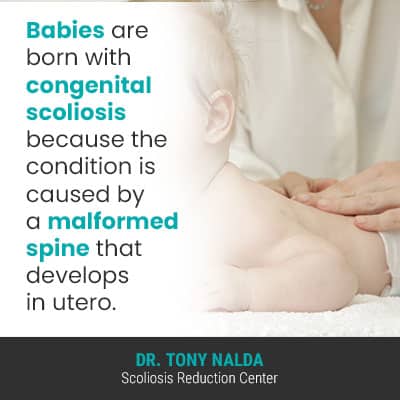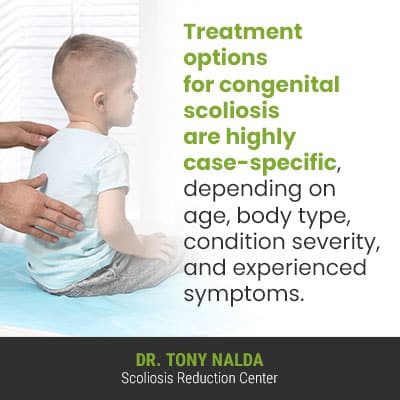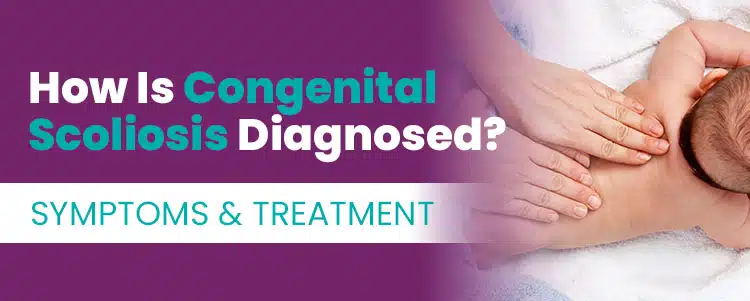While scoliosis is most prevalent in adolescents, it can affect all ages from babies to the elderly and every age in between. When scoliosis is classified as congenital, the condition developed due to a malformation within the spine itself that occurred before birth, of which there are different types; continue reading to learn more about this rare form of scoliosis.
When scoliosis is congenital, this means the condition developed prior to birth, when the spine was forming in utero. Congenital scoliosis is diagnosed by a physical examination and X-ray imaging to better see what’s happening in and around the spine. Symptoms and treatment needs are case-specific.
Part of the reason scoliosis is so often deemed a complex condition to treat is because in addition to it ranging so widely in severity, there are also multiple types a person can develop.
The Main Types of Scoliosis
When scoliosis is first diagnosed, further classifying conditions based on key patient/condition variables helps streamline the treatment process, plus shapes the design of customized treatment plans.
The condition’s classification points are patient age, curvature location, condition severity, and condition type (based on causation).
The most common type of scoliosis to affect both adults and children is idiopathic scoliosis, and the idiopathic designation means not clearly associated with a single-known cause.
Idiopathic scoliosis is, instead, considered to be multifactorial, meaning caused by a unique combination of multiple factors that can vary from patient to patient.
Under the umbrella of idiopathic scoliosis falls the most-prevalent type of scoliosis overall: adolescent idiopathic scoliosis (AIS), diagnosed between the ages of 10 and 18.
In fact, idiopathic scoliosis accounts for approximately 80 percent of known diagnosed scoliosis cases, and the remaining 20 percent consist of types with known causes: neuromuscular scoliosis, degenerative scoliosis, and congenital scoliosis.
Neuromuscular scoliosis can affect both children and adults, while degenerative scoliosis affects adults over the age of 40, and congenital scoliosis affects babies who are born with the condition.
What is Congenital Scoliosis?
Congenital scoliosis is a rare form, affecting approximately 1 in 10,000.
 Babies are born with congenital scoliosis because the condition is caused by a malformed spine that develops in utero.
Babies are born with congenital scoliosis because the condition is caused by a malformed spine that develops in utero.
When the vertebrae (bones of the spine) don’t form properly before the baby is born, the spine can form with an unnatural spinal curve; this isn’t always evident at birth, and in some cases, can become more noticeable with growth.
Scoliosis is a progressive condition, meaning it has it in its nature to worsen over time, and growth and development is the condition’s trigger for progression; oftentimes, it’s while growth is occurring that symptoms of congenital scoliosis can become more overt.
When scoliosis progresses, this means the unnatural sideways spinal curve, that also rotates, is getting larger, and as this happens, the condition’s uneven forces affecting the body are also increasing, as are their effects.
Congenital scoliosis can range from mild to severe, but it’s important to understand that as the spine forms at the same time as many other systems and parts within the body, congenital scoliosis patients often have other abnormalities so need to be comprehensively examined and monitored.
Symptoms of Congenital Scoliosis
As mentioned, although congenital scoliosis is present at birth, that’s not always when the condition is first detected.
In many cases, as the child grows, triggering its progression, congenital scoliosis becomes more noticeable.
While each case is unique, some common symptoms of congenital scoliosis can include:
- Uneven shoulders and/or shoulder blades (one side sits higher than the other)
- Uneven hips
- The head uncentered over the torso
- The development of a rib arch
- When the child is in a forward-bend position, the left and right sides of the back are uneven
Also as mentioned earlier, a malformed spine is an indicator that other issues related to malformations could be present, so congenital scoliosis patients sometimes present with these other symptoms as well:
- Pain and/or spasticity in the lower body
- A malformed hand, foot, or arm
- A stiff neck
- A short neck and/or spine
- Hearing impairment
- Bladder and/or kidney issues
- A number of issues related to bones, muscles, and/or joints
So now that we have defined the condition, along with exploring the other condition types, let’s address causation.
What Causes Congenital Scoliosis?
We know that it’s the spine not forming properly in utero that causes congenital scoliosis, but what types of abnormalities does that include?
Congenital scoliosis develops early in pregnancy and involves one or more vertebrae failing to form completely and/or properly.
In some cases, what’s known as a hemivertebra is the problem; this happens when a vertebral body is misshapen.
Healthy vertebrae are rectangular in shape, which allows for them to remain stacked on top of one another in a straight and neutral alignment, but if a vertebra is more triangular in shape, for example, this can cause a sharp angle and the inability for the spine to develop in a neutral and aligned position.
Another malformed spine can involve what’s known as fused vertebrae, and this happens when vertebral bodies fail to separate and form into distinct bones, instead becoming fused together into one solid bone.
In addition, compensatory curves can also be an issue.
When the spine loses one or more of its healthy curves, it can respond by putting in bad curves, in an effort to counteract the initial unnatural spinal curve’s presence, which can lead to more problems; for example, a malformed section in the lumbar spine (lower back) can cause the development of an unnatural spinal curve in the thoracic spine (middle/upper back) as the spine in the upper back attempts to compensate for the issues of the lower back.
In some cases of congenital scoliosis, a combination of these issues is present.
How is Congenital Scoliosis Diagnosed?
In order to officially diagnose congenital scoliosis, a doctor will perform a comprehensive physical exam, including taking the patient’s family history, with a focus on spinal conditions within the family.
In most cases, an X-ray is ordered to see what’s happening in and around the spine, and in many babies with congenital scoliosis, there are related issues with their spinal cords as well.
A magnetic resonance imaging (MRI) can also be performed to determine whether spinal cord issues are present or not; the spinal cord connects the brain to the rest of the body and is part of the central nervous system (CNS).
The spine forms at around 8 to 12 weeks of gestation, so doctors sometimes also order an ultrasound or echocardiogram to determine if other systems forming at the same time were also affected; these can include genital, urinary, and/or cardiac systems.
Treatment Options for Congenital Scoliosis
The reality is that congenital scoliosis is not a typical form of the condition, so can require more invasive forms of treatment.
 Treatment options for congenital scoliosis are highly case-specific, depending on age, body type, condition severity, and experienced symptoms.
Treatment options for congenital scoliosis are highly case-specific, depending on age, body type, condition severity, and experienced symptoms.
Some mild cases are monitored closely for signs of progression with growth, and if the curve doesn’t progress, despite the constant trigger of growth, further treatment might not be necessary.
While there are some nonsurgical treatment options such as bracing and modified forms of chiropractic and physical therapy, obviously, young patient age complicates treatment efficacy and ability, with some patients receiving surgical recommendations.
Conclusion
In typical cases of scoliosis, the unnatural spinal curve bends to the right, away from the heart, but in some atypical cases, the curve can bend to the left, towards the heart; when I see this, it’s an indicator that there is an underlying pathology at play, such as in cases of neuromuscular and/or congenital scoliosis.
When the spine forms properly between 8 and 12 weeks of gestation, the vertebrae are separate and rectangular in shape, and this allows them to remain stacked on top of one another in a straight and neutral alignment.
If the spine is aligned, its natural and healthy curves are in place, but if the spine loses one or more of its healthy curves, for any number of reasons, its overall function, strength, and health are disrupted.
Babies born with congenital scoliosis most often have it diagnosed when growth makes the condition progress and become more noticeable; other times, additional abnormalities detected lead to a comprehensive examination that reveals further malformations within the spine itself.
Congenital scoliosis patients need to be monitored closely for progression throughout growth, and for signs of other malformed body parts and/or systems.
Treatment needs are highly case-specific, and while, particularly in mild cases, treatment plans can be modified to address the unique challenges of treating patients of such a young age, surgical recommendations are a common option in severe cases.




